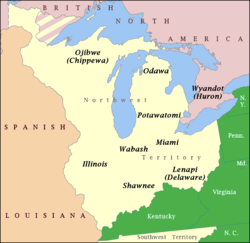
Many places throughout the state of Michigan take their names from Native American indigenous languages. This list includes counties, townships, and settlements whose names are derived from indigenous languages in Michigan.
Contents
- Municipalities
- State
- Counties
- Other settlements
- Natural features
- Bodies of water
- Islands
- Other
- See also
- References
- Citations
- Sources
The primary Native American languages in Michigan are Ojibwe, Odawa, and Potawatomi, all of which are dialects of Algonquin. Some other places names in Michigan are found to be derived from Sauk, Oneida, Wyandot, Abenaki, Shawnee, Mohawk, Seneca, Seminole, Iroquois, and Delaware, although many of these tribes are not found in Michigan.